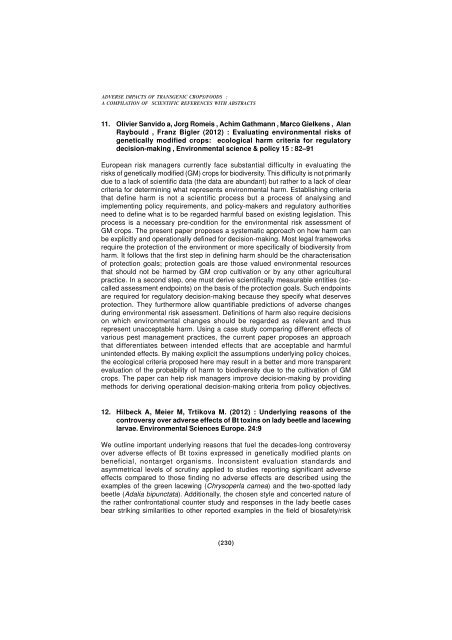omb3dyw
omb3dyw
omb3dyw
You also want an ePaper? Increase the reach of your titles
YUMPU automatically turns print PDFs into web optimized ePapers that Google loves.
ADVERSE IMPACTS OF TRANSGENIC CROPS/FOODS :A COMPILATION OF SCIENTIFIC REFERENCES WITH ABSTRACTS11. Olivier Sanvido a, Jorg Romeis , Achim Gathmann , Marco Gielkens , AlanRaybould , Franz Bigler (2012) : Evaluating environmental risks ofgenetically modified crops: ecological harm criteria for regulatorydecision-making , Environmental science & policy 15 : 82–91European risk managers currently face substantial difficulty in evaluating therisks of genetically modified (GM) crops for biodiversity. This difficulty is not primarilydue to a lack of scientific data (the data are abundant) but rather to a lack of clearcriteria for determining what represents environmental harm. Establishing criteriathat define harm is not a scientific process but a process of analysing andimplementing policy requirements, and policy-makers and regulatory authoritiesneed to define what is to be regarded harmful based on existing legislation. Thisprocess is a necessary pre-condition for the environmental risk assessment ofGM crops. The present paper proposes a systematic approach on how harm canbe explicitly and operationally defined for decision-making. Most legal frameworksrequire the protection of the environment or more specifically of biodiversity fromharm. It follows that the first step in defining harm should be the characterisationof protection goals; protection goals are those valued environmental resourcesthat should not be harmed by GM crop cultivation or by any other agriculturalpractice. In a second step, one must derive scientifically measurable entities (socalledassessment endpoints) on the basis of the protection goals. Such endpointsare required for regulatory decision-making because they specify what deservesprotection. They furthermore allow quantifiable predictions of adverse changesduring environmental risk assessment. Definitions of harm also require decisionson which environmental changes should be regarded as relevant and thusrepresent unacceptable harm. Using a case study comparing different effects ofvarious pest management practices, the current paper proposes an approachthat differentiates between intended effects that are acceptable and harmfulunintended effects. By making explicit the assumptions underlying policy choices,the ecological criteria proposed here may result in a better and more transparentevaluation of the probability of harm to biodiversity due to the cultivation of GMcrops. The paper can help risk managers improve decision-making by providingmethods for deriving operational decision-making criteria from policy objectives.12. Hilbeck A, Meier M, Trtikova M. (2012) : Underlying reasons of thecontroversy over adverse effects of Bt toxins on lady beetle and lacewinglarvae. Environmental Sciences Europe. 24:9We outline important underlying reasons that fuel the decades-long controversyover adverse effects of Bt toxins expressed in genetically modified plants onbeneficial, nontarget organisms. Inconsistent evaluation standards andasymmetrical levels of scrutiny applied to studies reporting significant adverseeffects compared to those finding no adverse effects are described using theexamples of the green lacewing (Chrysoperla carnea) and the two-spotted ladybeetle (Adalia bipunctata). Additionally, the chosen style and concerted nature ofthe rather confrontational counter study and responses in the lady beetle casesbear striking similarities to other reported examples in the field of biosafety/risk(230)


